2014 HONDA CIVIC COUPE tire pressure
[x] Cancel search: tire pressurePage 22 of 46

21
Maintenance
Maintenance MinderTM To Use Maintenace MinderTM
Maintenance Service Items
2345
Maintenance Service ItemsIndependent of the Maintenance Minder
•information, replace the brake fluid every 3 years.
Inspect idle speed every 160,000 miles (256,000
•km).
Adjust the valves during services A, B, 1, 2, or 3 if
•they are noisy.
CODE Maintenance Main Items
A Replace engine oil •
*1
B Replace engine oil• *1 and oil filter
Replace fuel filter element (low pressure)
•
Drain fuel filter (high pressure)
•
Inspect front and rear brakes/service as necessary
•
Check parking brake adjustment
•
Inspect tie rod ends, steering gearbox, and boots
•
Inspect suspension components
•
Inspect driveshaft boots
•
Inspect brake hoses and lines (Including ABS/ VSA)
•
Inspect all fluid levels and condition of fluids
•
Inspect exhaust system
• #
Inspect fuel lines and connections
• #
Check the expiration date for TRK bottle
• *2
CODE Maintenance Sub Items
1 Rotate tires •
2 Replace air cleaner element• *3
Replace dust and pollen filter
• *4
Replace fuel filter element (high pressure)
•
Inspect drive belt
•
Inspect valve clearance
•
Inspect fuel tank
• *5
3 Replace transmission fluid •
4 Replace spark plugs•
5 Replace engine coolant•
*1: If a message SERVICE does not appear more than 12 months after the display is reset, change the
engine oil every year.
*2: Models with tire repair kit
# : See information on maintenance and emissions warranty. *3: If you drive in dusty conditions, replace the air cleaner element every 15,000 miles (24,000 km).
*4: If you drive primarily in urban areas that have high concentrations of soot in the air from industry and
from diesel-powered vehicles, replace the dust and pollen filter every 15,000 miles (24,000 km).
*5: If sub item 2 does not appear more than 36 months after the display is reset, inspect the fuel tank
every three years.
See CNG tank expiration and production dates on page 5 for inspection and replacement
information. Fuel tank should be replaced 15 years after it was manufactured.
System Message
Indicator
Maintenance Minder
Message
Main
Item Sub Items
2014 Civic CNG
Page 30 of 46
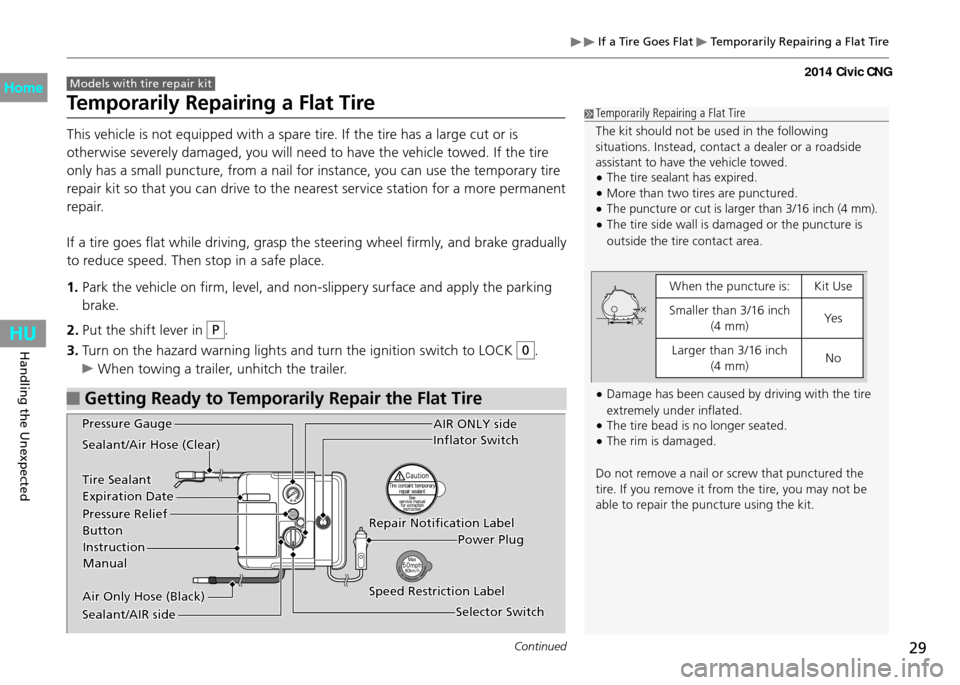
29Continued
Handling the Unexpected
If a Tire Goes Flat Temporarily Repairing a Flat Tire
Models with tire repair kit
Temporarily Repairing a Flat Tire
This vehicle is not equipped with a spare tire. If the tire has a large cut or is
otherwise severely damaged, you will need to have the vehicle towed. If the tire
only has a small puncture, from a nail for instance, you can use the temporary tire
repair kit so that you can drive to the nearest service station for a more permanent
repair.
If a tire goes flat while driving, grasp the steering wheel firmly, and brake gradually
to reduce speed. Then stop in a safe place.
1. Park the vehicle on firm, level, and non-slippery surface and apply the parking
brake.
2. Put the shift lever in
P.
3. Turn on the hazard warning lights and turn the ignition switch to LOCK
0.
When towing a trailer, unhitch the trailer.
Getting Ready to Temporarily Repair the Flat Tire
AIR ONLY side
Inflator Switch
Repair Notification Label
Power Plug
Speed Restriction Label
Selector Switch
Pressure Gauge
Sealant/Air Hose (Clear)
Tire Sealant
Expiration Date
Pressure Relief
Button
Instruction
Manual
Air Only Hose (Black)
Sealant/AIR side
Temporarily Repairing a Flat Tire
The kit should not be used in the following
situations. Instead, contact a dealer or a roadside
assistant to have the vehicle towed.
The tire sealant has expired.
•More than two tires are punctured.
•The puncture or cut is larger than 3/16 inch (4 mm).
•The tire side wall is damaged or the puncture is
•outside the tire contact area.
When the puncture is: Kit Use
Smaller than 3/16 inch (4 mm) Ye s
Larger than 3/16 inch (4 mm) No
Damage has been caused by driving with the tire
•extremely under inflated.
The tire bead is no longer seated.
•The rim is damaged.
•
Do not remove a nail or screw that punctured the
tire. If you remove it from the tire, you may not be
able to repair the puncture using the kit.
2014 Civic CNG
Page 33 of 46
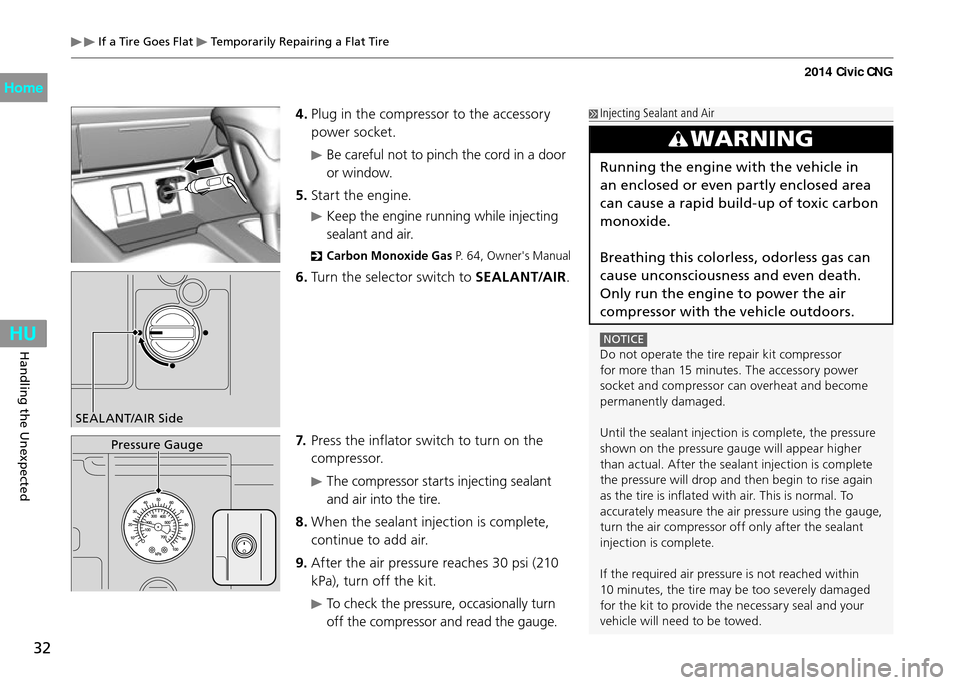
32
Handling the Unexpected
If a Tire Goes Flat Temporarily Repairing a Flat Tire
4. Plug in the compressor to the accessory
power socket.
Be careful not to pinch the cord in a door
or window.
5. Start the engine.
Keep the engine running while injecting
sealant and air.
Carbon Monoxide Ga s
P. 64, Owner's Manual
6. Turn the selector switch to SEALANT/AIR .
7. Press the inflator switch to turn on the
compressor.
The compressor starts injecting sealant
and air into the tire.
8. When the sealant injection is complete,
continue to add air.
9. After the air pressure reaches 30 psi (210
kPa), turn off the kit.
To check the pressure, occasionally turn
off the compressor and read the gauge.
Injecting Sealant and Air
SEAL ANT/AIR Side
Pressure Gauge
WARNING
Running the engine with the vehicle in
an enclosed or even partly enclosed area
can cause a rapid build-up of toxic carbon
monoxide.
Breathing this colorless, odorless gas can
cause unconsciousness and even death.
Only run the engine to power the air
compressor with the vehicle outdoors.
NOTICE Do not operate the tire repair kit compressor
for more than 15 minutes. The accessory power
socket and compressor can overheat and become
permanently damaged.
Until the sealant injection is complete, the pressure
shown on the pressure gauge will appear higher
than actual. After the sealant injection is complete
the pressure will drop and then begin to rise again
as the tire is inflated with air. This is normal. To
accurately measure the air pressure using the gauge,
turn the air compressor off only after the sealant
injection is complete.
If the required air pressure is not reached within
10 minutes, the tire may be too severely damaged
for the kit to provide the necessary seal and your
vehicle will need to be towed.
2014 Civic CNG
Page 34 of 46
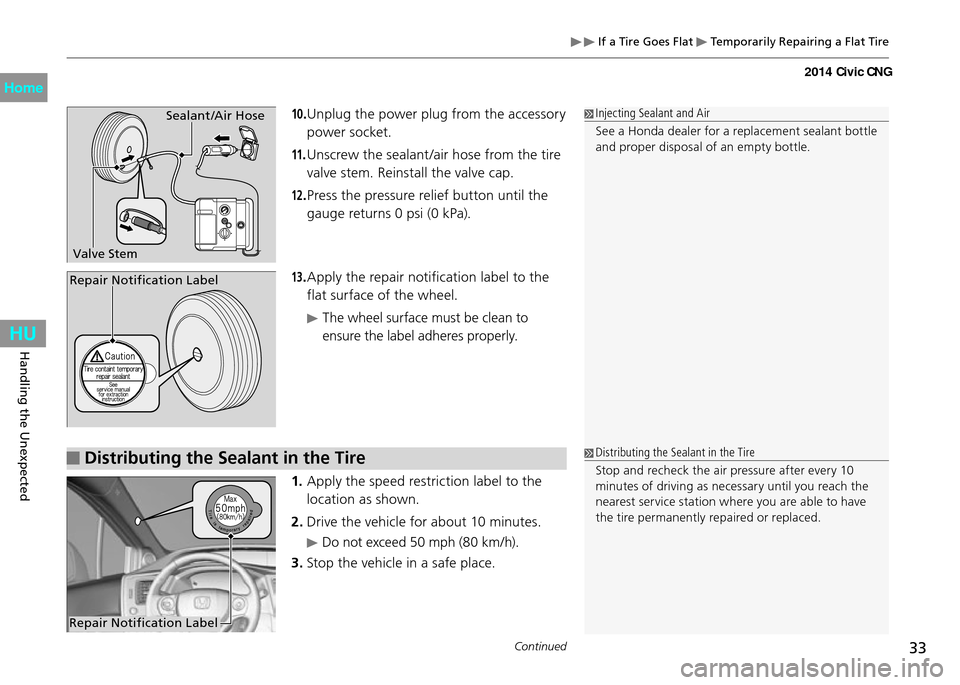
33Continued
Handling the Unexpected
If a Tire Goes Flat Temporarily Repairing a Flat Tire
10. Unplug the power plug from the accessory
power socket.
11. Unscrew the sealant /air hose from the tire
valve stem. Reinstall the valve cap.
12. Press the pressure relief button until the
gauge returns 0 psi (0 kPa).
13. Apply the repair notification label to the
flat surface of the wheel.
The wheel surface must be clean to
ensure the label adheres properly.
Repair Notification LabelValve Stem Sealant /Air Hose
Distributing the Sealant in the Tire
Repair Notification Label
1.
Apply the speed restriction label to the
location as shown.
2. Drive the vehicle for about 10 minutes.
Do not exceed 50 mph (80 km/h).
3. Stop the vehicle in a safe place.
Injecting Sealant and Air
See a Honda dealer for a replacement sealant bottle
and proper disposal of an empty bottle.
Distributing the Sealant in the Tire
Stop and recheck the air pressure after every 10
minutes of driving as necessary until you reach the
nearest service station where you are able to have
the tire permanently repaired or replaced.
2014 Civic CNG
Page 35 of 46
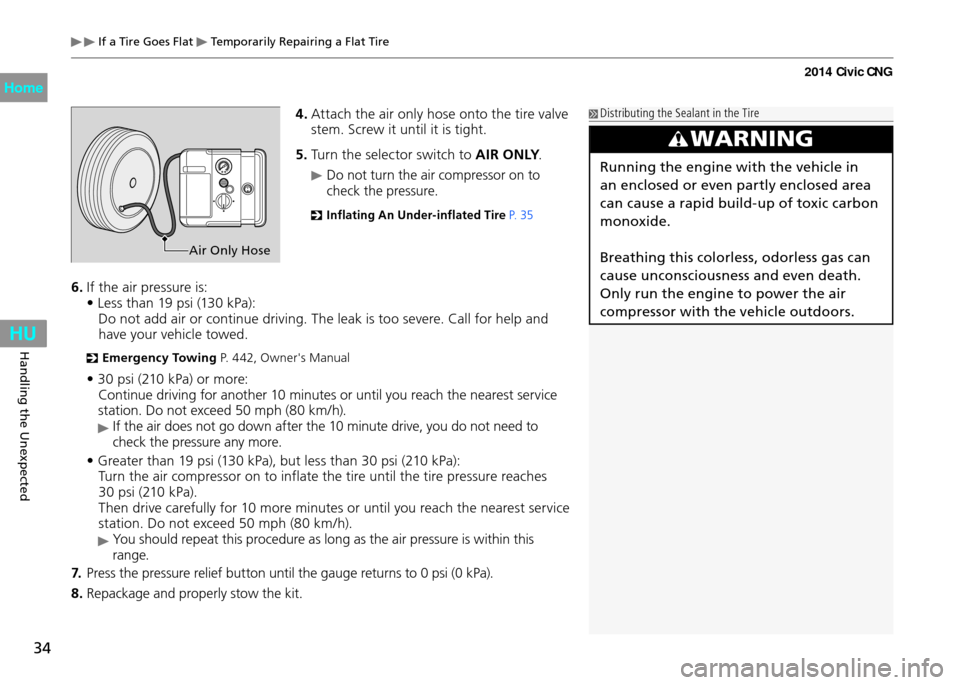
34
Handling the Unexpected
If a Tire Goes Flat Temporarily Repairing a Flat Tire
4. Attach the air only hose onto the tire valve
stem. Screw it until it is tight.
5. Turn the selector switch to AIR ONLY .
Do not turn the air compressor on to
check the pressure.
Inflating An Under-inflated Tire
P. 35
Air Only Hose
Distributing the Sealant in the Tire
WARNING
Running the engine with the vehicle in
an enclosed or even partly enclosed area
can cause a rapid build-up of toxic carbon
monoxide.
Breathing this colorless, odorless gas can
cause unconsciousness and even death.
Only run the engine to power the air
compressor with the vehicle outdoors.
6. If the air pressure is:
• Less than 19 psi (130 kPa):
Do not add air or continue driving. The leak is too severe. Call for help and
have your vehicle towed.
Emergency Towin g
P. 442, Owner's Manual
• 30 psi (210 kPa) or more:
Continue driving for another 10 minutes or until you reach the nearest service
station. Do not exceed 50 mph (80 km/h).
If the air does not go down after the 10 minute drive, you do not need to
check the pressure any more.
• Greater than 19 psi (130 kPa), but less than 30 psi (210 kPa):
Turn the air compressor on to inflate the tire until the tire pressure reaches
30 psi (210 kPa).
Then drive carefully for 10 more minutes or until you reach the nearest service
station. Do not exceed 50 mph (80 km/h).
You should repeat this procedure as long as the air pressure is within this
range.
7. Press the pressure relief button until the gauge returns to 0 psi (0 kPa).
8. Repackage and properly stow the kit.
2014 Civic CNG
Page 37 of 46
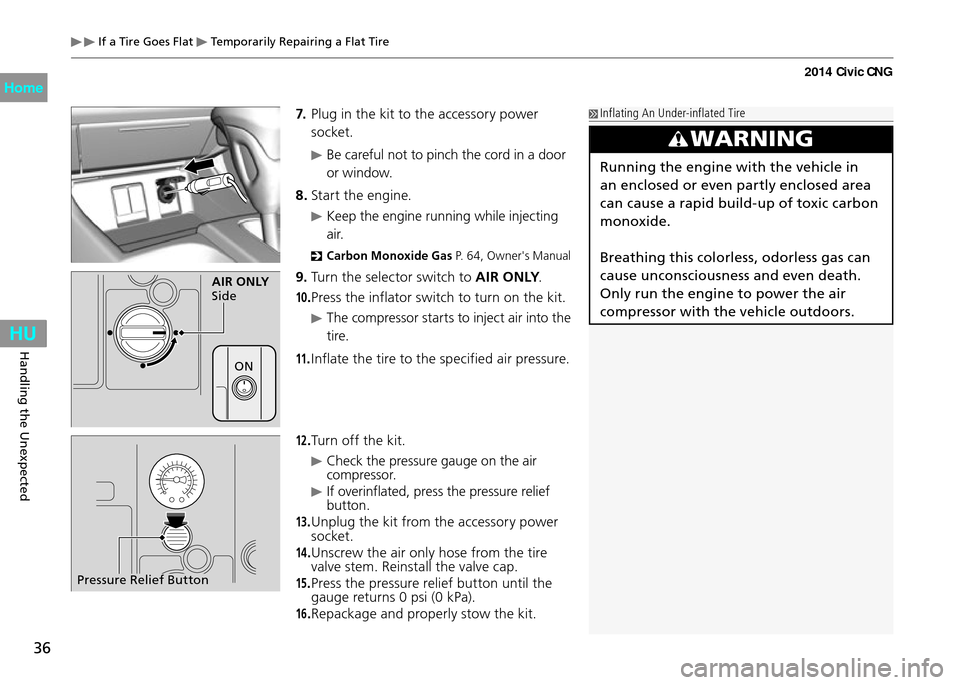
36
Handling the Unexpected
If a Tire Goes Flat Temporarily Repairing a Flat Tire
7. Plug in the kit to the accessory power
socket.
Be careful not to pinch the cord in a door
or window.
8. Start the engine.
Keep the engine running while injecting
a i r.
Carbon Monoxide Ga s
P. 64, Owner's Manual
9. Turn the selector switch to AIR ONLY .
10. Press the inflator switch to turn on the kit.
The compressor starts to inject air into the
tire.
11. Inflate the tire to the specified air pressure.
12. Turn off the kit.
Check the pressure gauge on the air
compressor.
If overinflated, press the pressure relief
button.
13. Unplug the kit from the accessory power
socket.
14. Unscrew the air only hose from the tire
valve stem. Reinstall the valve cap.
15. Press the pressure relief button until the
gauge returns 0 psi (0 kPa).
16. Repackage and properly stow the kit.
Inflating An Under-inflated Tire
AIR ONLY
Side
Pressure Relief Button
WARNING
Running the engine with the vehicle in
an enclosed or even partly enclosed area
can cause a rapid build-up of toxic carbon
monoxide.
Breathing this colorless, odorless gas can
cause unconsciousness and even death.
Only run the engine to power the air
compressor with the vehicle outdoors.
ON
2014 Civic CNG
Page 44 of 46

Specifications
43
Information
Brake Fluid
SpecifiedHonda Heavy Duty Brake Fluid DOT 3
Automatic Transmission Fluid
Specified Honda ATF DW-1
(automatic transmission fluid)
Capacity Change 2.5 US qt (2.4 ℓ)
Engine Oil
Recommended • Genuine Honda Motor Oil 0W-20
• API Premium-grade 0W-20
detergent oil
Capacity Change
3.7 US qt (3.5 ℓ)
Change
including
filter 3.9 US qt (3.7 ℓ)
Engine Coolant
Specified
Honda Long-Life Antifreeze/Coolant
Ty pe2
Ratio 50/50 with distilled water
Capacity 1.45 US gal (5.50 ℓ)
(change including the remaining
0.125 US gal (0.475 ℓ) in the reserve tank)
Tire
RegularSize
P195/65R15 89H
Pressure
psi (kPa[kgf/cm2]) 30 (210 [2.1])
Compact
Spare
*1
Size T135/80D15 99M
Pressure
psi (kPa[kgf/cm
2]) 60 (420 [4.2])
Wheel Size Regular
15 x 6J
Compact Spare
*115 x 4T
*1: Models with compact spare tire
2014 Civic CNG